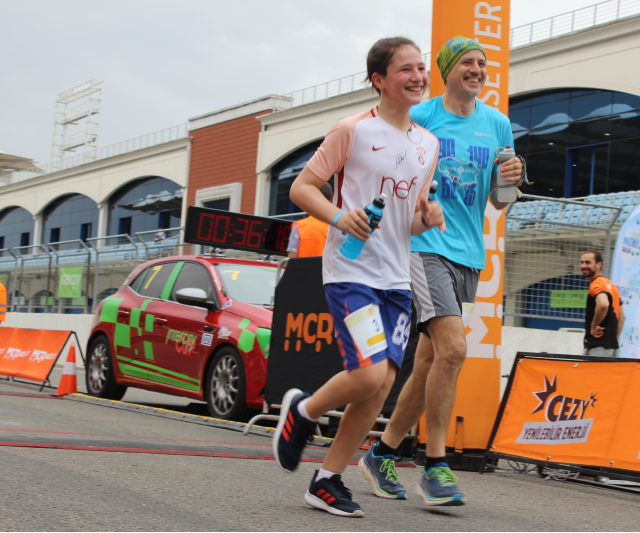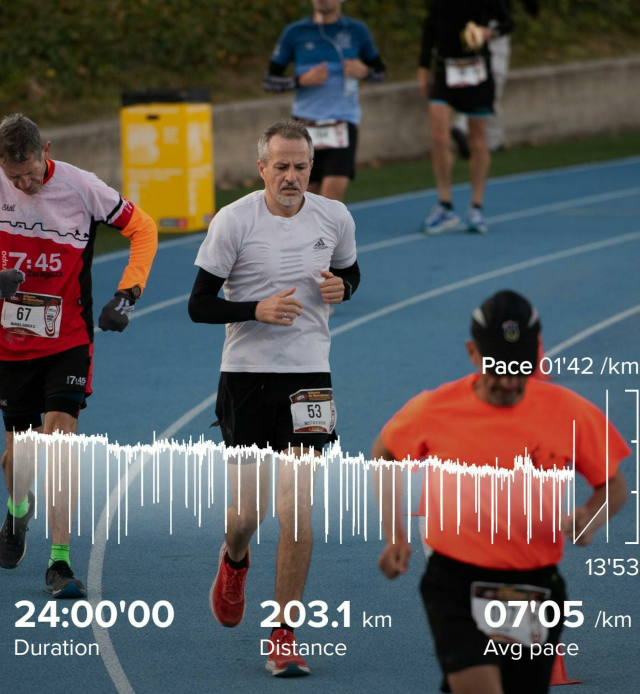2022-May-26
Did you know? You can share this story using the social media icons on the upper left. Use the hashtag #WeAreCisco. You can also rate or comment on the story below.
Why I Run for 24 Hours
BY BUDAK TIMURALP · SOLUTIONS ACCOUNT MANAGER · TURKEY
5 MINUTE READ · 7 MINUTE LISTEN
How did I run 203 kilometers (126 miles) in 24 hours at the age of 46?
It all started in 2015 when I had a very unhealthy lifestyle.
I was about to turn 40. My greatest pleasures were drinking, watching my favorite DJs on weekends, and returning home early in the morning.
My lifestyle wasn’t sustainable. I knew I had to change something. (And I wanted to have a healthy lifestyle so I could drink more.)
I asked my friend about running. Not just any friend. My pal had completed many ultramarathons — even longer races than standard marathons.
One rainy February morning, he invited me to join him on a beach run.
While I could barely finish five kilometers (three miles) on a treadmill, I could run seven kilometers (a little over four miles) outdoors. After the run, I felt great. This experience motivated me to run more.
My motto became “The man who runs to drink.”
I followed my friend’s training program, which required me to get up at 5:30 every morning to balance work and family.
As someone who usually goes to bed around 1 a.m., this was a challenge for me. It was easy to get up early for client meetings, but it was tough to find motivation to run on cold and dark mornings.
After months of dedicated training — both physically and mentally — I eventually completed the Istanbul Marathon in 4:14 in November 2015.

From there, I was hooked.
Over the next three years, I ran a 51K ultramarathon in Las Vegas, Nevada; a 100K in Eugene, Oregon; a 120K in Cappadocia, Turkey; and a 160K in Iznik, Turkey.
As my body got used to running, I noticed that I could better plan my day at work as a solutions account manager. I came up with even better business solutions for Vodafone to increase our sales.
I also learned that as the distances increased, my mind played a much more important role. My long runs and races had taught me that it’s almost always the mind which gives up first.
Then came COVID-19 and the lockdowns. Running had a profound effect on my mental health, but I couldn’t participate in races for a year and a half.
Once restrictions were lifted, I found my new goal: I wanted to run a 24-hour race in Barcelona in December 2021.
The rules were simple: Run as much as you can on the sixth lane of the track (437.7 meters or 1,436 feet) in 24 hours.
It was a big challenge for two main reasons: First of all, there were no scenery changes, so you needed to be mentally focused for 24 hours around the same track.
And the injury risk was higher.
Unlike a trail race where you use different muscles for climbing and descending, every step on a track is virtually the same. If your body isn’t used to that kind of stress, it’s a recipe for repetitive strain injury.
The race started at noon.
I ran past the marathon mark in four hours as I had planned.
The thing with the track races is that GPS watches are not very reliable because of the constant curves. And in a 24-hour race, pacing is critical. You’ll most likely blow up in the second half of the race if you start even a little bit fast.
On the other hand, to reach my target goal of more than 200 kilometers (126 miles), I needed to run at a certain pace which meant I couldn’t be too slow.
The hours passed very slowly. At midnight, I learned that I had covered 113 kilometers (70 miles) in 12 hours. I was on pace for my target, but was also getting tired.
I kept pushing as much as I could and passed the 161 kilometer (100 mile) mark around 6 a.m., which boosted my morale.
At least temporarily. I still had the equivalent of another marathon to run.

Up until that point, I never stopped moving forward except for a few restroom breaks, but restarting my run after these breaks was incredibly difficult. My mind tried every trick to make me stop. It was a never-ending battle.
But when the 24-hour time expired, I was able to run 464 laps with a total distance of 203.093 kilometers (126.256 miles). Thanks to my donors, we managed to help 150 community volunteers.
My 24-hour race around the track was a six-year journey of substituting my drinking addiction with running.
Running has made me a completely different person. I can say that the most important thing about running ultramarathons is that it makes you much more resilient against the difficulties of life.
This experience reminds me of a quote from the German poet Goethe: “Enjoy when you can, endure when you must.”
Whether running a marathon or this race we call life, enjoy the fun and easy times. However, endure the hard moments, too.
Cisco has several employee resources such as the #SafeToTalk community, Employee and Family Assistance Program, and Days for Me to help you get through them.
It’s these challenging moments that define endurance races of any kind.
Employee Resources
- Employee and Family Assistance Program
- Join an Inclusive Community
- Global Wellbeing Community
- Join the #SafeToTalk Webex space
- Learning & Development
- Share your story
Related Links
Connect everything. Innovate everywhere. Benefit everyone.
Share your thoughts!
Log in to rate and commentShare your thoughts on the story here!